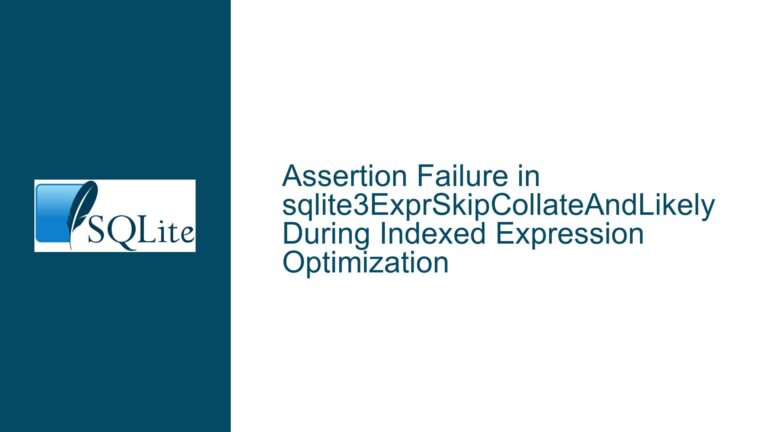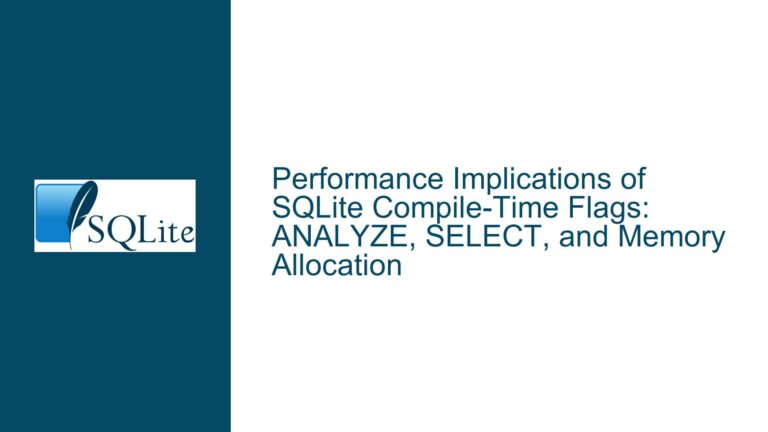Efficient Custom Ordering in SQLite FTS with Thread-Based Sorting
Efficient FTS Querying with Thread-Based Secondary Ordering
Issue Overview
The core issue revolves around optimizing Full-Text Search (FTS) queries in SQLite when a secondary ordering criterion is required. Specifically, the scenario involves an FTS table (message_fts) that indexes messages, with each message having a unique rowid that encodes the message’s receive date. This encoding allows for efficient sorting by message receive date. However, the requirement is to also sort the results based on the most recent date of any message within the thread to which each matched message belongs. This secondary ordering is stored in a separate table (thread), which contains the most_recent date for each thread.
The challenge lies in performing this secondary ordering efficiently, especially given the scale of the database (4.2 million messages). The current approach of joining the message_fts table with the thread table results in performance degradation, particularly when paginating results. The goal is to achieve lightning-fast searches while avoiding full table scans or expensive joins.
Possible Causes
The performance bottleneck in this scenario can be attributed to several factors:
Join Overhead: The need to join the
message_ftstable with thethreadtable to retrieve themost_recentdate for each thread introduces significant overhead. This is particularly problematic when dealing with large datasets, as the join operation can result in a full table scan, which is computationally expensive.Indexing Limitations: While the
rowidin themessage_ftstable is optimized for sorting by message receive date, there is no built-in support for secondary indexing based on thread-related criteria. This limitation forces the query to rely on joins or other less efficient methods to achieve the desired sorting.Write-Heavy Updates: The proposed solution of rewriting every message FTS row with an updated
docid(embedding the thread order) upon receiving a new message is write-heavy. This approach, while potentially effective, could lead to performance issues during high write throughput, especially in scenarios where threads contain a large number of messages (up to 200 in some cases).Pagination Complexity: Paginating results based on both message receive date and thread receive date adds another layer of complexity. The query must not only retrieve the correct set of messages but also ensure that the pagination logic respects both ordering criteria, which can be challenging to implement efficiently.
Troubleshooting Steps, Solutions & Fixes
To address the performance issues and achieve efficient custom ordering in SQLite FTS with thread-based sorting, several strategies can be employed:
Materialized Views: One approach is to create a materialized view that precomputes the necessary join between the
message_ftsandthreadtables. This view would include therowidfrommessage_fts, themost_recentdate fromthread, and any other relevant columns. By materializing this view, the join operation is performed once, and subsequent queries can directly access the precomputed results, significantly reducing query execution time.Composite Indexing: Another strategy is to create a composite index that includes both the
rowidfrommessage_ftsand themost_recentdate fromthread. This index would allow the database to efficiently sort and filter results based on both criteria without requiring a full table scan. However, this approach may require careful tuning to ensure that the index is used optimally by the query planner.Denormalization: Denormalizing the schema by embedding the
most_recentdate directly into themessage_ftstable could eliminate the need for joins altogether. This would involve updating themessage_ftstable whenever a new message is added to a thread, ensuring that themost_recentdate is always up-to-date. While this approach reduces query complexity, it increases write overhead and requires careful management to maintain data consistency.Hybrid Approach: A hybrid approach could combine elements of the above strategies. For example, a materialized view could be used for read-heavy operations, while denormalization could be employed for write-heavy scenarios. This approach would require balancing the trade-offs between read and write performance, but it could provide a more flexible solution that adapts to different usage patterns.
Query Optimization: Optimizing the query itself can also yield significant performance improvements. This includes using appropriate indexing, avoiding unnecessary columns in the SELECT clause, and leveraging SQLite’s query planner hints to guide the execution plan. Additionally, breaking down complex queries into smaller, more manageable parts can help the query planner make better decisions.
Caching: Implementing a caching layer for frequently accessed data can further enhance performance. By caching the results of expensive queries, subsequent requests can be served directly from the cache, reducing the load on the database. This approach is particularly effective for read-heavy applications where the same data is accessed repeatedly.
Asynchronous Updates: To mitigate the write-heavy nature of updating the
message_ftstable with newdocidvalues, asynchronous updates can be employed. This involves deferring the update operation to a background process, allowing the main application to continue processing requests without being blocked by write operations. This approach requires careful handling to ensure data consistency but can significantly improve overall system performance.Partitioning: Partitioning the
message_ftstable based on thread ID or another relevant criterion can help distribute the data more evenly across the database. This can reduce the impact of large joins and improve query performance by limiting the scope of the data that needs to be processed. Partitioning can be particularly effective in scenarios where data access patterns are predictable and can be aligned with the partitioning strategy.Query Rewriting: Rewriting the query to leverage SQLite’s strengths can also yield performance improvements. For example, using subqueries or Common Table Expressions (CTEs) to break down complex joins into simpler components can help the query planner optimize execution. Additionally, using window functions or other advanced SQL features can provide more efficient ways to achieve the desired sorting and filtering.
Monitoring and Tuning: Continuous monitoring and tuning of the database performance is essential to identify and address any bottlenecks. This includes analyzing query execution plans, monitoring resource usage, and adjusting configuration parameters as needed. Regular maintenance tasks such as vacuuming and analyzing the database can also help maintain optimal performance over time.
By carefully considering these strategies and tailoring them to the specific requirements of the application, it is possible to achieve efficient custom ordering in SQLite FTS with thread-based sorting. The key is to balance the trade-offs between read and write performance, leverage SQLite’s strengths, and continuously monitor and optimize the database to ensure it meets the application’s needs.






